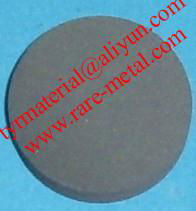Product Description
Zirconium boride, ZrB2 sputtering targets
Purity: 99.5%
Shape: Discs, disks, step disk, delta, plate, sheets or made per drawing
Diameter: 355.6mm (14") max.
Single piece Size: Length: <500mm, Width: <250mm, Thickness: >1mm, if larger size than this, we can do it as Tiles joint by 45 degree or 90 degree
Molar mass: 112.85, melting point of 3246 °C. density: ~6.09 g/cm3,
Made sputtering targets method: hot pressing (HP), hot/cold isostatic pressing (HIP, CIP), and vacuum melting, vacuum sintering
Zirconium diboride (ZrB2) is a highly covalent refractory ceramic material with a hexagonal crystal structure. ZrB2 is an ultra high temperature ceramic (UHTC) with a melting point of 3246 °C. This along with its relatively low density of ~6.09 g/cm3 (measured density may be higher due to hafnium impurities) and good high temperature strength makes it a candidate for high temperature aerospace applications such as hypersonic flight or rocket propulsion systems. It is an unusual ceramic, having relatively high thermal and electrical conductivities, properties it shares with isostructural titanium diboride and hafnium diboride.
ZrB2 parts are usually hot pressed (pressure applied to the heated powder) and then machined to shape. Sintering of ZrB2 is hindered by the material's covalent nature and presence of surface oxides which increase grain coarsening before densification during sintering. Pressureless sintering of ZrB2 is possible with sintering additives such as boron carbide and carbon which react with the surface oxides to increase the driving force for sintering but mechanical properties are degraded compared to hot pressed ZrB2.
Additions of ~30 vol% SiC to ZrB2 is often added to ZrB2 to improve oxidation resistance through SiC creating a protective oxide layer - similar to aluminum's protective alumina layer.
Label︰
Zirconium boride (ZrB2) sputtering targets

